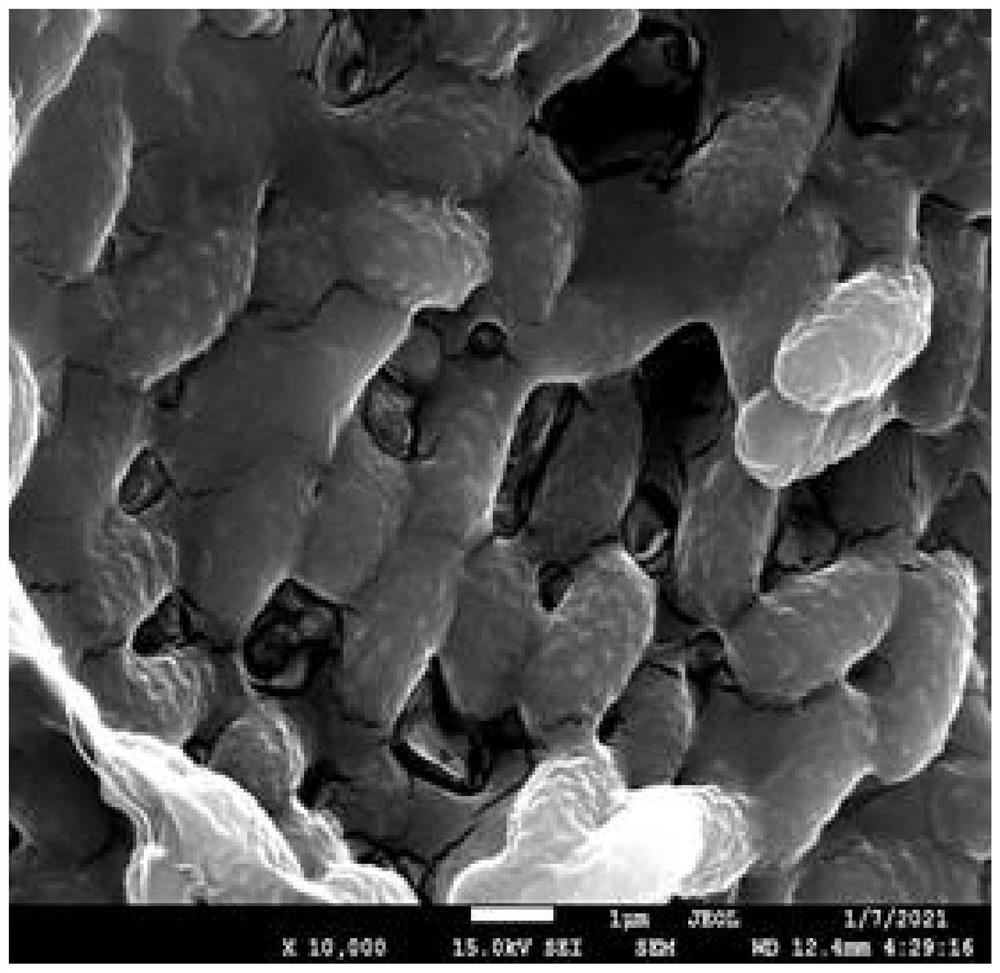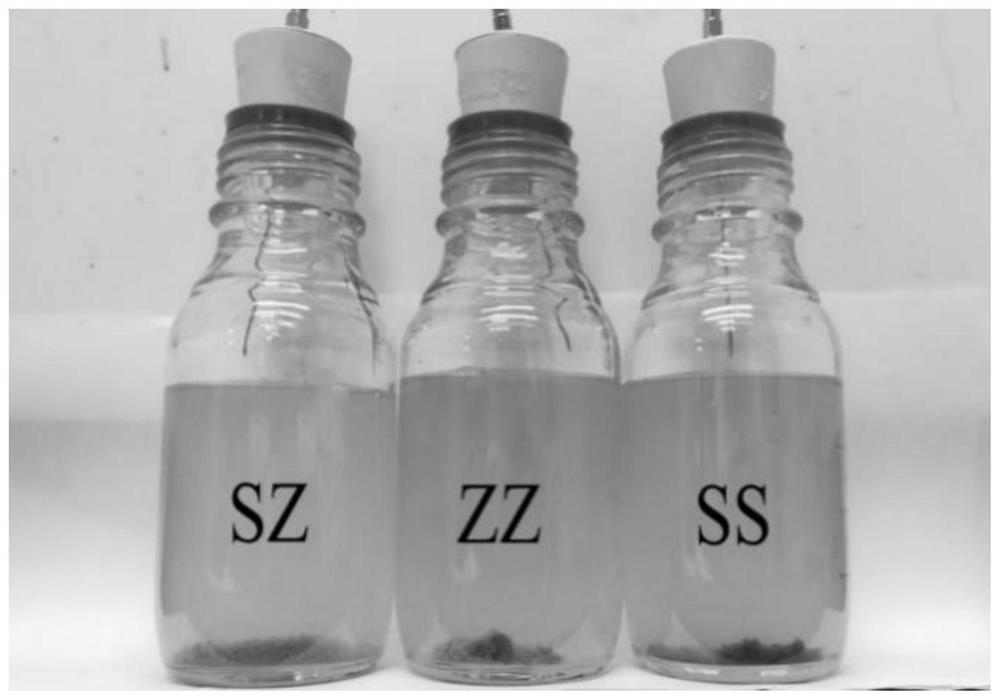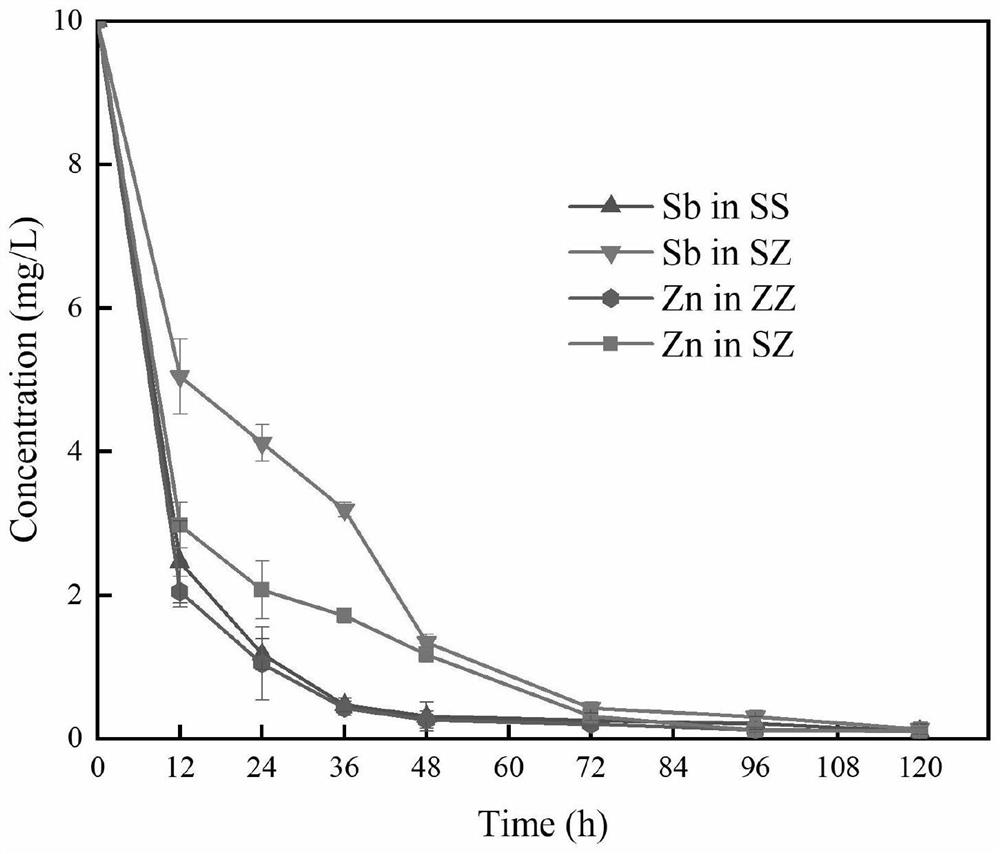Repairing method for remediation of antimony and zinc combined pollution and application
A technology for compound pollution and restoration method is applied to the restoration method and application field of restoration of antimony and zinc compound pollution, which can solve the problems of high cost of antimony and zinc pollution treatment, and the inability to repair antimony and zinc compound pollution at the same time, and achieves good industrial application. Prospects, reducing environmental pollution, and the effect of low cost
- Summary
- Abstract
- Description
- Claims
- Application Information
AI Technical Summary
Problems solved by technology
Method used
Image
Examples
Embodiment 1
[0038] Embodiment 1 A kind of remediation method for repairing antimony and zinc composite pollution
[0039] 1. Enrichment and domestication of sulfate-reducing bacteria
[0040] Enrichment medium formula: K 2 HPO 4 0.5 g / L, Na 2 SO 4 1 g / L, MgSO 4 ·7H 2 O 2g / L, CaCl 2 ·6H 2 O0.1g / L, NH 4 Cl 1g / L, yeast extract 1g / L, sodium lactate 1g / L, ascorbic acid 0.5g / L; pH 7.0±0.2.
[0041] Weigh 1g of the mine sample and inoculate it into a reactor containing 100mL enriched medium, and add 0.5g / LFe(NH 4 ) 2 ·(SO 4 ) 2 ·6H 2O, fill the reactor with nitrogen for 5 minutes to discharge the oxygen in the reactor, seal the bottle cap and place it in an incubator at 30°C for 5 days. After the liquid turns black and it turns black with lead acetate test paper, you can smell the obvious smell of rotten eggs when you open the bottle mouth, indicating that there is H in the bottle mouth. 2 S gas is produced, and the sulfate-reducing bacteria have grown in large numbers at this t...
experiment example 1
[0046] Identification of Experimental Example 1 Reaction Product
[0047] After one reaction cycle, the precipitate in SZ was collected, centrifuged and dried for characterization. Figure 4 (a) is the scanning electron micrograph of microorganisms, compared to figure 1 There is no clear short rod shape, and the whole is covered by a layer of things. It is speculated that the bacterial flora may be covered by the formed sediment. combine Figure 4 (b) and Table 1, it can be seen that the reaction products are mainly composed of C, O, S, P, Cl, Na, Mg, Sb, Zn and other elements, wherein the existence of C, O, and P is due to the The presence of organic matter, Cl, Na, Mg may be attributed to the culture medium of microorganisms, while the presence of elemental S and Zn, Sb may be due to the fixation of Sb(III) and Zn(II) as sulfide precipitates. In order to further verify this hypothesis, the precipitates generated in the SZ reactor were analyzed in combination with XRD. Su...
experiment example 2
[0051] Analysis of pH and TOC changes in the reactor of Experimental Example 2
[0052] The TOC value in the reaction process is detected by a total organic carbon analyzer, and the pH in the reaction process is detected by a pH meter. The result is as Image 6 As shown, the concentration of TOC gradually decreased in the first three days as the reaction progressed and gradually stabilized thereafter, indicating that sodium lactate acted as Electron donors and carbon sources, also indicated in previous studies. The pH of the solution first decreased, then increased slowly, and finally stabilized at about 6.5, indicating that the pH after the reaction was finally stabilized at neutral conditions without causing an extreme acid-base environment.
PUM
 Login to View More
Login to View More Abstract
Description
Claims
Application Information
 Login to View More
Login to View More - R&D
- Intellectual Property
- Life Sciences
- Materials
- Tech Scout
- Unparalleled Data Quality
- Higher Quality Content
- 60% Fewer Hallucinations
Browse by: Latest US Patents, China's latest patents, Technical Efficacy Thesaurus, Application Domain, Technology Topic, Popular Technical Reports.
© 2025 PatSnap. All rights reserved.Legal|Privacy policy|Modern Slavery Act Transparency Statement|Sitemap|About US| Contact US: help@patsnap.com



